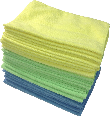Butcher blocks have long been an extremely popular choice among most home chefs, and even professional chefs. In fact, these have become so popular that the wooden material is becoming an ever increasing popular choice for tables and countertops. There is just one thing wrong with utilizing this material as a cutting board, or even just having it in the kitchen. That problem is that if you don't take the proper care you can easily damage the wood, or not kill off all the germs that can collect on it. To ensure that you do a thorough job, simply follow these guidelines.
- Wash thoroughly. The very first step in butcher block cleaning is to do a basic washing. To do this, you can very easily use some regular water and regular liquid dishwashing soap or detergent. When you do this, use a nonabrasive cloth or sponge to do this, as you don't want to create any micro-abrasions in the wood which could harbor and contain bacteria, germs, or microbes. Once you have washed the block completely, dry off the wood using another soft cloth.
- Apply some bleach. Once you have completely washed and dried the butcher block you need to begin killing off any bacteria that may have been left behind. To do this, create a cleaning mixture of about one tablespoon of bleach with about a gallon of warm water. Wipe this mixture over the block with a clean soft rag.
- Use some lemon juice. For particularly nasty stains, you can simply pour a bit of lemon juice onto the surface, and allowing it to soak there for awhile. This in effect will act as a bit of bleach, and help you to remove the stain. Simply wash the lemon juice off in the same manner as listed above.
- Apply some mineral oil. If your butcher block is unvarnished then you will need to add another step to your cleaning regimen. That step is to apply some nontoxic mineral oil to your butcher block. On average, you will only need to do this once about every other week, or if you are really paranoid about your butcher block, every week. This will in effect act as a type of varnish that will help protect the wood, and help prevent any nasty bacteria soaking into the wood.
- Wash again. After you have applied either the bleach, lemon juice, or even the mineral oil, you will need to wash everything again. Be sure that when you do this you follow the same exact procedure that you used initially. You want to make sure that you remove any and all traces of the cleaning and maintenance fluids so that it will not adversely effect the food you prepare on it.
Author Bio
Lee Wyatt
Contributor of numerous Tips.Net articles, Lee Wyatt is quickly becoming a regular "Jack of all trades." He is currently an independent contractor specializing in writing and editing. Contact him today for all of your writing and editing needs! Click here to contact. Learn more about Lee...
Growing Award Winning Tomatoes
If you are interested in having some great vegetables in your garden, why not go all out? Growing award winning tomatoes ...
Discover More
Designing a Garden for Color
Color is an extremely important part of designing a garden, and unfortunately one many people overlook. Instead of ...
Discover More
Removing Shingles
Every so often, the roof of our homes will need a little care and maintenance. One of the most common ways that we have ...
Discover More
Disinfecting Your Kitchen Sponge
Most people don't stop to think about cleaning their cleaning tools, and that is a rather sad state of affairs. The truth ...
Discover More
Caring for Copper Kitchen Sinks
Do you have a copper kitchen sink in your home? If so, then hopefully you know the proper way to care for it. Otherwise, ...
Discover More
Cleaning Your Freezer
Cleaning your freezer doesn't need to be an all-day job. Keep your frozen foods cold by housing them in your kitchen ...
Discover More

Comments